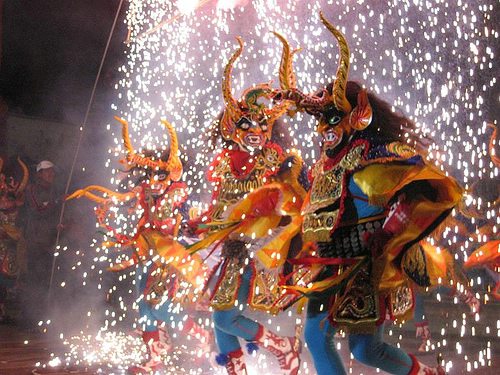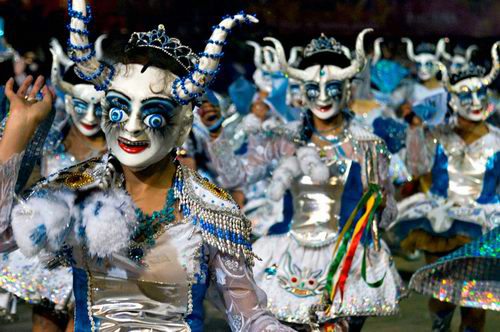
Carnaval is celebrated throughout South America. It is a festive time when huge celebrations of dance and music break out in Brazil, Ecuador, Colombia, and even in the highlands of Bolivia. One of the most unique and interesting Carnavals in South America is Carnaval de Oruro, or La Diablada Carnival. It takes place in the mining town of Oruro, in central Bolivia. The festival is spread out over the course of four days, with 18 hours of parties and parades each of those days.
This year’s Carnaval de Oruro, Bolivia takes place Friday, February 21 to Monday February 24, 2020. Below we’ll talk about some of the most exciting highlights of this epic festival.
*This article was last updated in February 2020 by Gina Cronin
Two famous icons have popularized the festival, namely the earth-mother Pachamama and the Uncle/God of the mountains Tio Supay, who transforms into the devil for these festivities. This malevolent devil character has single-handedly contributed to the charm that attracts visitors annually to Oruro to celebrate their version of Carnival.

Costumed devils dance to appease the spirits and offer sacrifices, beer, food and coca to the Tio. Photo By: OVRL – Flickr
Be prepared to be captivated by the diablada or devil dance during the Carnaval de Oruro. These symbolic dances are representations of the battle of good over evil. The entry of Lucifer Tio Supay commences the entire event. He is followed by large groups of dancers, each representing a different form of Bolivian dance. These devils stand-out in their pink tights, red and white boots decorated with dragons and serpents, velvet capes sewn with silver thread, coins and small mirrors. They can be seen sporting long, golden-haired wigs and their signature frightening masks and feature great horns, bulging eyes and jagged teeth.

Locals believe that dressing up like devils will ward away evil spirits – kind of like Halloween in the US
There are many notable characters that attend the festival such as the Devil’s wife China Supay who seductively dances to entice the Archangel Michael. Encircling her are intoxicatingly dancing members of the local worker union, each carrying a small union symbol such as a pickax or shovel. Dancers dress as Incas with condor headdresses, dancers with suns and moons on their chests along with black slaves that represent those who were once imported by Spaniards to work in silver mines.
The processional dance melodrama known as the morenada. It commemorates the sacrifice of enslaved Africans who worked with Indian laborers in the Bolivian mines and in the lowland plantations. Different characters appear in the groups such as black slaves, slave drivers and Spaniards, each bearing a distinctive mask and costume. Dancers do a mournful sideways sweep to imitate men dragging chains bound to their legs.
This festival is filled to the brim with Bolivian culture and tradition. Numerous plays are enacted throughout the festival. One in particular is a festival highlight that centers on the theme Good vs. Evil. The procession is directed towards the church where both angels and devils are forced to sit side by side. The priest blesses each angel and assigns them the task to kill seven devils each, representing the seven deadly sins. Pachamama emerges and the angels try to kill her as well, but Pachamama begs for forgiveness and is ultimately liberated. In the background are Las Bandas playing traditional folk songs, filling the air with their music.
The procession ends inside of the Socavon Cathedral in the center of town. Participants crawl on their knees to honor the town’s patron saint, the Virgin of Socavon. Although this may seem like the end to the party, there are still three more days left until Ash Wednesday. These final days of celebration, las bandas can still be heard and locals and tourists alike take to drinking Bolivian beer and chicha, a fermented corn beverage.
Like Carnival in many other South American countries, water fights are prominent in Oruro. It is nearly impossible to stay dry during this time which makes it difficult to capture the moment through pictures. If attending the festival, it is highly likely you’ll be hit with a water balloon or perhaps an entire bucket of water will be emptied onto you. Beware that in Oruro, spray foam is often used to bombard Carnival onlookers.
Carnaval de Oruro, Bolivia is one of the most fascinating, especially for those travelers who have an interest in understanding the mixture of indigenous and European traditions. If you go, keep in mind there are hundreds of thousands of people, so be sure to keep close to your group and keep your personal belongings safe and snug.
Interested in visiting Bolivia? Check out our Andean Treasures and Bolivia Highlights travel package or contact us to plan a customized Bolivian vacation.


Email: [email protected]
Sign up to receive our newsletter for great articles, stunning photos, and special deals.